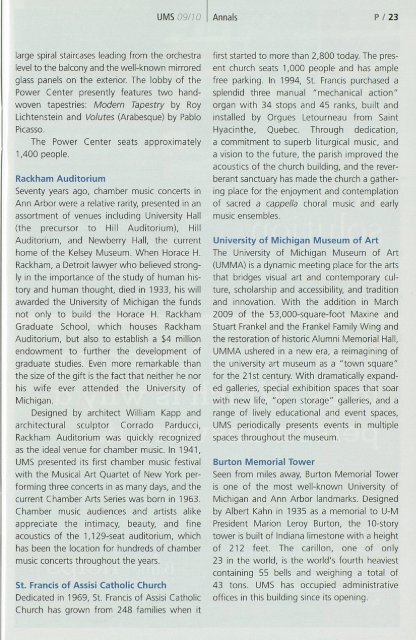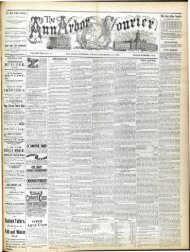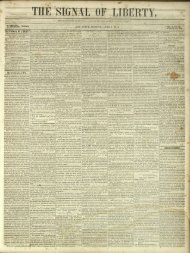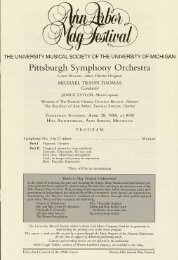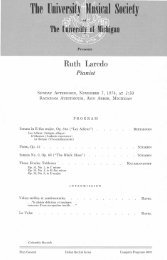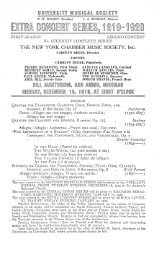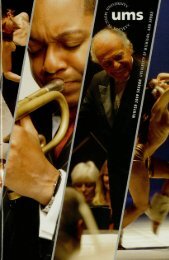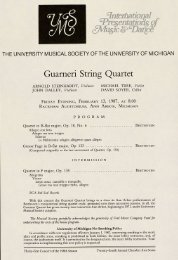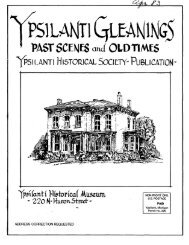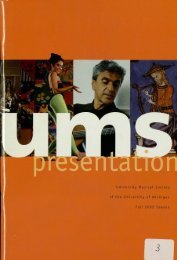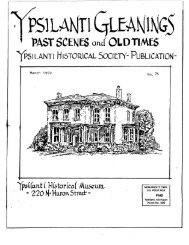university musical society - Ann Arbor District Library
university musical society - Ann Arbor District Library
university musical society - Ann Arbor District Library
Create successful ePaper yourself
Turn your PDF publications into a flip-book with our unique Google optimized e-Paper software.
large spiral staircases leading from the orchestra<br />
level to the balcony and the well-known mirrored<br />
glass panels on the exterior. The lobby of the<br />
Power Center presently features two hand-<br />
woven tapestries: Modem Tapestry by Roy<br />
Lichtenstein and Volutes (Arabesque) by Pablo<br />
Picasso.<br />
The Power Center seats approximately<br />
1,400 people.<br />
Rackham Auditorium<br />
Seventy years ago, chamber music concerts in<br />
<strong>Ann</strong> <strong>Arbor</strong> were a relative rarity, presented in an<br />
assortment of venues including University Hall<br />
(the precursor to Hill Auditorium), Hill<br />
Auditorium, and Newberry Hall, the current<br />
home of the Kelsey Museum. When Horace H.<br />
Rackham, a Detroit lawyer who believed strong<br />
ly in the importance of the study of human his<br />
tory and human thought, died in 1933, his will<br />
awarded the University of Michigan the funds<br />
not only to build the Horace H. Rackham<br />
Graduate School, which houses Rackham<br />
Auditorium, but also to establish a $4 million<br />
endowment to further the development of<br />
graduate studies. Even more remarkable than<br />
the size of the gift is the fact that neither he nor<br />
his wife ever attended the University of<br />
Michigan.<br />
Designed by architect William Kapp and<br />
architectural sculptor Corrado Parducci,<br />
Rackham Auditorium was quickly recognized<br />
as the ideal venue for chamber music. In 1941,<br />
UMS presented its first chamber music festival<br />
with the Musical Art Quartet of New York per<br />
forming three concerts in as many days, and the<br />
current Chamber Arts Series was born in 1963.<br />
Chamber music audiences and artists alike<br />
appreciate the intimacy, beauty, and fine<br />
acoustics of the 1,129-seat auditorium, which<br />
has been the location for hundreds of chamber<br />
music concerts throughout the years.<br />
St. Francis of Assisi Catholic Church<br />
Dedicated in 1969, St. Francis of Assisi Catholic<br />
Church has grown from 248 families when it<br />
UMS; <strong>Ann</strong>als P/23<br />
first started to more than 2,800 today. The pres<br />
ent church seats 1,000 people and has ample<br />
free parking. In 1994, St. Francis purchased a<br />
splendid three manual "mechanical action"<br />
organ with 34 stops and 45 ranks, built and<br />
installed by Orgues Letourneau from Saint<br />
Hyacinthe, Quebec. Through dedication,<br />
a commitment to superb liturgical music, and<br />
a vision to the future, the parish improved the<br />
acoustics of the church building, and the rever<br />
berant sanctuary has made the church a gather<br />
ing place for the enjoyment and contemplation<br />
of sacred a cappella choral music and early<br />
music ensembles.<br />
University of Michigan Museum of Art<br />
The University of Michigan Museum of Art<br />
(UMMA) is a dynamic meeting place for the arts<br />
that bridges visual art and contemporary cul<br />
ture, scholarship and accessibility, and tradition<br />
and innovation. With the addition in March<br />
2009 of the 53,000-square-foot Maxine and<br />
Stuart Frankel and the Frankel Family Wing and<br />
the restoration of historic Alumni Memorial Hall,<br />
UMMA ushered in a new era, a reimagining of<br />
the <strong>university</strong> art museum as a "town square"<br />
for the 21st century. With dramatically expand<br />
ed galleries, special exhibition spaces that soar<br />
with new life, "open storage" galleries, and a<br />
range of lively educational and event spaces,<br />
UMS periodically presents events in multiple<br />
spaces throughout the museum.<br />
Burton Memorial Tower<br />
Seen from miles away, Burton Memorial Tower<br />
is one of the most well-known University of<br />
Michigan and <strong>Ann</strong> <strong>Arbor</strong> landmarks. Designed<br />
by Albert Kahn in 1935 as a memorial to U-M<br />
President Marion Leroy Burton, the 10-story<br />
tower is built of Indiana limestone with a height<br />
of 212 feet. The carillon, one of only<br />
23 in the world, is the world's fourth heaviest<br />
containing 55 bells and weighing a total of<br />
43 tons. UMS has occupied administrative<br />
offices in this building since its opening.


